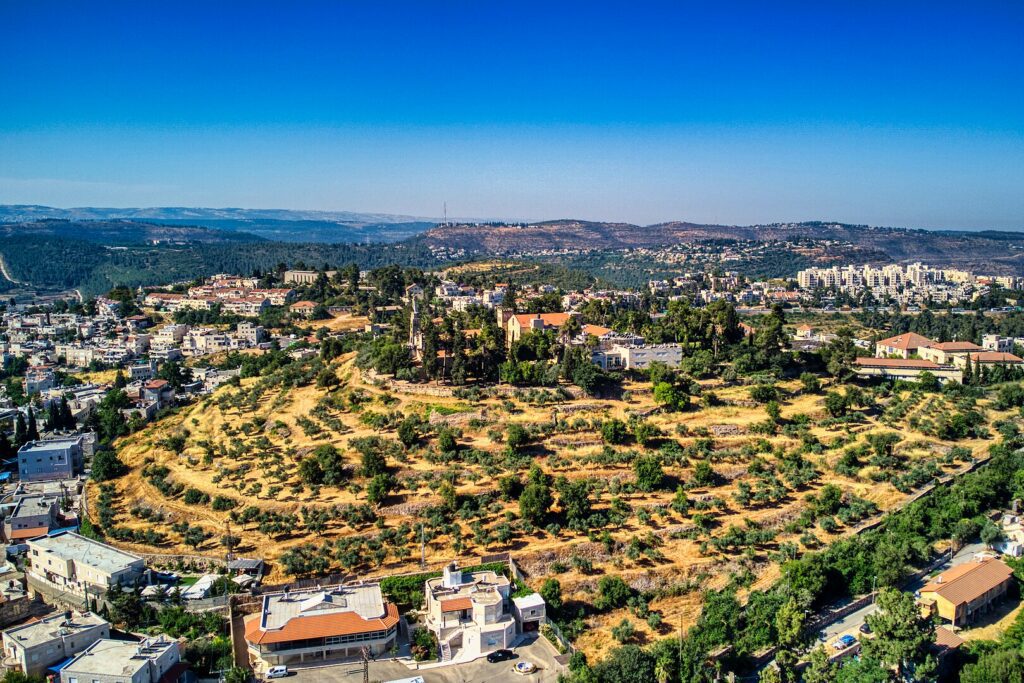Kiriath-jearim is a biblical city identified with Deir el-Azar near Abu Ghosh. This identification was first suggested by the French scholar Louis-Hugues Vincent in 1907. The suggestion was based on four factors: (1) The preservation of the name of Elazar, the guardian of the Ark of the Covenant at Kiriath-jearim (1 Samuel 7:1) in the name ‘Deir el-Azar’. (2) The close proximity of the site to other biblical sites known to have been in the vicinity of Kiriath-jearim. (3) The site’s location matching Eusebius’s description of the site. (4) The preservation of the name ‘Kiriath’ in ‘Qaryat al-‘Inab’, the former name of Abu Ghosh, which lies at the base of the tel. This identification wasn’t accepted immediately, but after American scholar Francis Cook concluded in 1924 that this suggestion was most likely correct, it came to be accepted by the scholarly world. Kiriath-jearim is especially known as the place where the Ark of the Covenant stood for 20 years (1 Samuel 7:1).


History of the Site’s Research
The tel is thought to cover an area of some 7 hectares. At its center stands the monastery and church of ‘Our Lady of the Ark of the Covenant’. These were built over the Byzantine monastery of the same name, dated to the 4th or 5th century CE, and excavated by French nobleman Comte Marie Paul Amedee de Piellat in 1905, shortly before the new monastery and church were erected. The monastery’s location in the center of the tel prevents excavating that area, but over the years several excavations took place in other areas of the tel: In the years 1995-1996 a salvage excavation led by Gabriel Barkay was conducted prior to the construction of a new building on the grounds of the monastery and church. In the years 2014-2015 and 2017 a few small salvage excavations were conducted by the Israel Antiquities Authority on the edge of the tel. In 2017 and 2019 large-scale excavations were conducted at the top of the tel (near the church and monastery) by a joint expedition from Tel-Aviv University and the Collège de France, headed by Israel Finkelstein and Thomas Römer. Several excavations have also been conducted in the area of Abu Ghosh.
The Site from the Neolithic Period to the Iron Age
Findings from the excavations reveal that the site was first settled during the Neolithic period (5500-4500 BCE). At the base of the tel, near Abu Ghosh, another Neolithic site was found. From the Early Bronze Age (3500-2500 BCE) to the Iron Age IIA (included) (10th century BCE), the site was settled in minimal capacity. The site’s first settlement peak occurred during the Iron IIB-IIC period (9th-8th centuries BCE). A large, raised platform which covered a significant part of the site is dated to the first part of that period. It is not currently known whether the builders were Judahites, Israelites or Assyrians. Near this complex a relatively large structure was found, containing animal bones. It’s possible that this building served as a cultic site. To the end of that period should be associated a number of Judahite jars with seal impressions, including a ‘LMLK’ jar, as well as a Canaanite figurine, and a few tombs found on the slopes of the tel, containing various pottery vessels dated to that period. In the Iron III period (7th-6th centuries BCE) the site’s settlement was considerably reduced. It appears that the site was not destroyed during the Babylonian destruction but was abandoned sometime during the 6th century BCE.
The Site from the Persian Period to the Roman Period
It’s possible that there was limited activity at the site during the Persian period (539-332 BCE). The site was resettled in limited capacity in the beginning of the Hellenistic period (332-2nd century BCE). During the 2nd century BCE the raised platform complex was renovated, likely as part of a series of renovation and fortification efforts undertaken by the Seleucids. It’s possible that these fortifications were part of the fortification system built by the Seleucid commander Bacchides in the Land of Israel during the Hasmonean Revolt. The site reached another settlement peak in the Late-Hellenistic-Early Roman period (1st century BCE-1st century CE). Settlement at the site continued over the course of the Roman period and onward.
Bibliography:
I. Finkelstein and others, ‘Excavations at Kiriath-jearim near Jerusalem, 2017: Preliminary Report’, Semitica 60 (2018), pp. 31-83.
I. Finkelstein and others, ‘Excavations at Kiritah-jearim, 2019: Preliminary Report’, Tel Aviv 48 (2021), pp. 47-72.
I. Finkelstein and T. Römer, ‘Kiriath-jearim and the List of Bacchides Forts in 1 Maccabees 9:50-52’, in: O. Peleg-Barkat and others (eds.), New Studies in the Archaeology of Jerusalem and its Region: Collected Papers XIII (2019), pp. *7-*17.
C. McKinny and others, ‘Kiriath-Jearim (Deir el-ʿÂzar): Archaeological Investigations of a Biblical Town in the Judaean Hill Country’, Israel Exploration Journal, pp. 30-49
H. Vincent, ‘Église Byzantine et Inscription Romaine a Abou-Ghôch’, Revue Biblique 4 (1907), pp. 414-421

